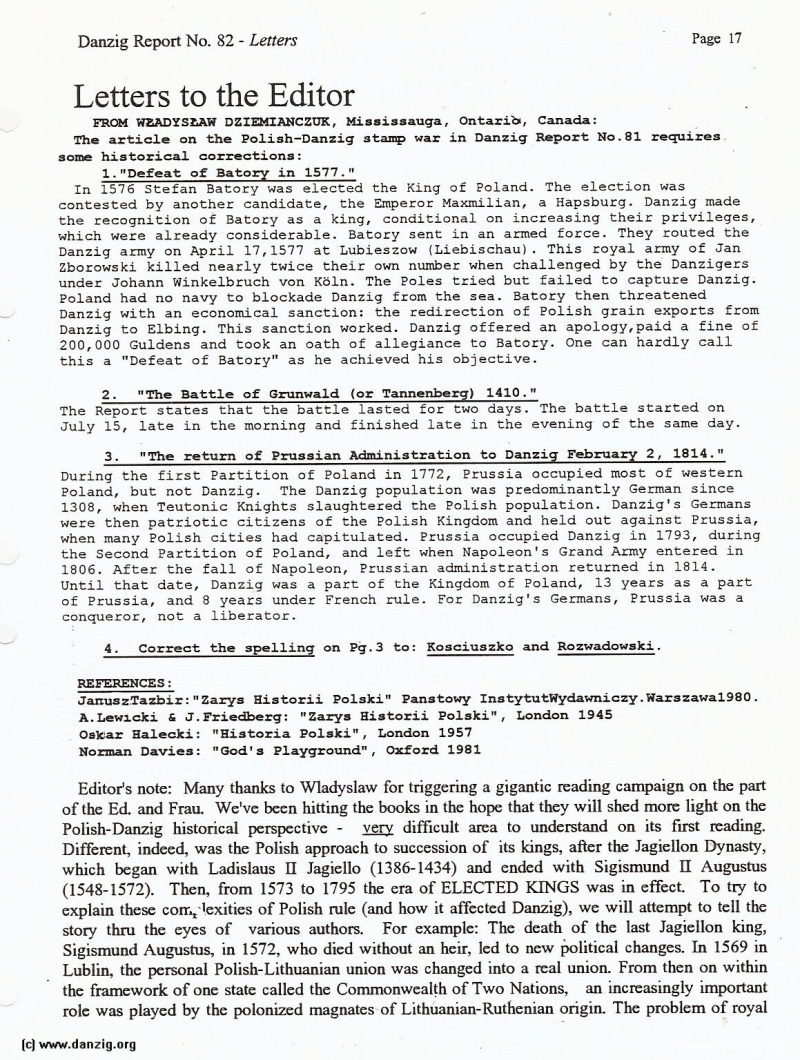
Letters to the Editor
FROM WZADYSLAW DZIEMIANCZUK, Missiasauga, Ontari, Canada:
The article on the Polish-Danzig stamp war in Danzig Report No.81 requires some historical corrections:
1.”Defeat of Batory in 1577.”
In 1576 Stefan Batory was elected the King of Poland. The election was contested by another candidate, the Emperor Maxmilian, a Hapsburg. Danzig made the recognition of Batory as a king, conditional on increasing their privileges, which were already considerable. Batory sent in an armed force. They routed the Danzig army on April 17,1577 at Lubieszow (Liebischau). This royal army of Jan Zborowski killed nearly twice their own number when challenged by the Danzigers under Johann Winkeibruch von Koln. The Poles tried but failed to capture Danzig. Poland had no navy to blockade Danzig from the sea. Batory then threatened Danzig with an economical sanction: the redirection of Polish grain exports from Danzig to Elbing. This sanction worked. Danzig offered an apology,paid a fine of 200,000 Guldens and took an oath of allegiance to Batory. One can hardly call
this a “Defeat of Batory” as he achieved his objective.
2. “The Battle of Grunwaid (or Tannenberg) 1410.”
The Report states that the battle lasted for two days. The battle started on July 15, late in the morning and finished late in the evening of- the same day.
3. “The return of Prussian Administration to Danzig February 2, 1814.”
During the first Partition of Poland in 1772, Prussia occupied most of western Poland, but not Danzig. The Danzig population was predominantly German since 1308, when Teutonic Knights slaughtered the Polish population. Danzig’s Germans were then patriotic citizens of the Polish Kingdom and held out against Prussia, when many Polish cities had capitulated. Prussia occupied Danzig in 1793, during the Second Partition of Poland, and left when Napoleon’s Grand Army entered in 1806. After the fall of Napoleon, Prussian administration returned in 1814. Until that date, Danzig was a part of the Kingdom of Poland, 13 years as a part of Prussia, and 8 years under French rule. For Danzig’s Germans, Prussia was a conqueror, not a liberator.
4. Correct the spelling on Pg.3 to: Kosciuszko and Rozwadowski.
REFERENCES:
JanuszTazbir: “Zarys Historii Poiski” Panstowy InstytutWydawniczy.Warszawal980.
A.Lew.cki & J.Friedberg: “Zarys ilistorii Poiski”, London 1945
Osicar Halecki: “Historia Poiski”, London 1957
Norman Davies: “God’s Playground”, Oxford 1981
Editor’s note: Many thanks to Wiadyslaw for triggering a gigantic reading campaign on the part of the Ed. and Frau. We’ve been hitting the books in the hope that they will shed more light on the Polish-Danzig historical perspective - yy difficult area to understand on its first reading. Different, indeed, was the Polish approach to succession of its kings, after the Jagiellon Dynasty, which began with Ladislaus II Jagiello (1386-1434) and ended with Sigismund U Augustus (1548-1572). Then, from 1573 to 1795 the era of ELECTED KINGS was in effect. To try to explain these coir1’1exities of Polish rule (and how it affected Danzig), we will attempt to tell the story thru the eyes of various authors. For example: The death of the last Jagiellon king, Sigismund Augustus, in 1572, who died without an heir, led to new political changes. In 1569 in Lublin, the personal Polish-Lithuanian union was changed into a real union. From then on within the framework of one state called the Commonwealth of Two Nations, an increasingly important role was played by the polonized magnates of Lithuanian-Ruthenian origin. The problem of royal
Danzig Report Vol. 1 - Nr. 82 - January - February - March - 1994, Page 19.
Hits: 3077
Added: 06/07/2015
Copyright: 2025 Danzig.org

